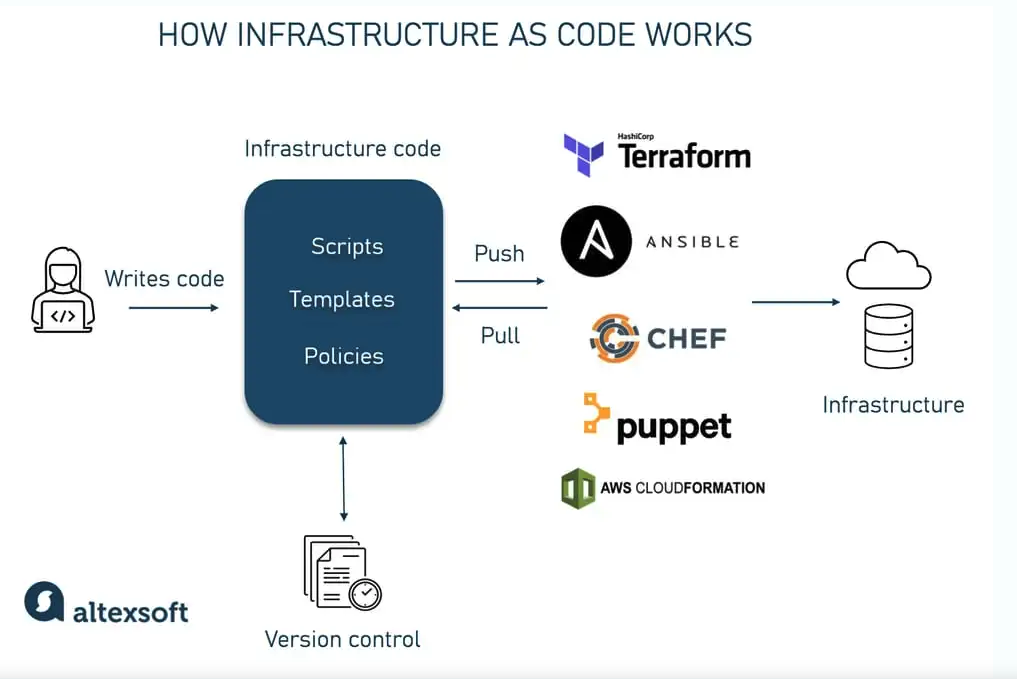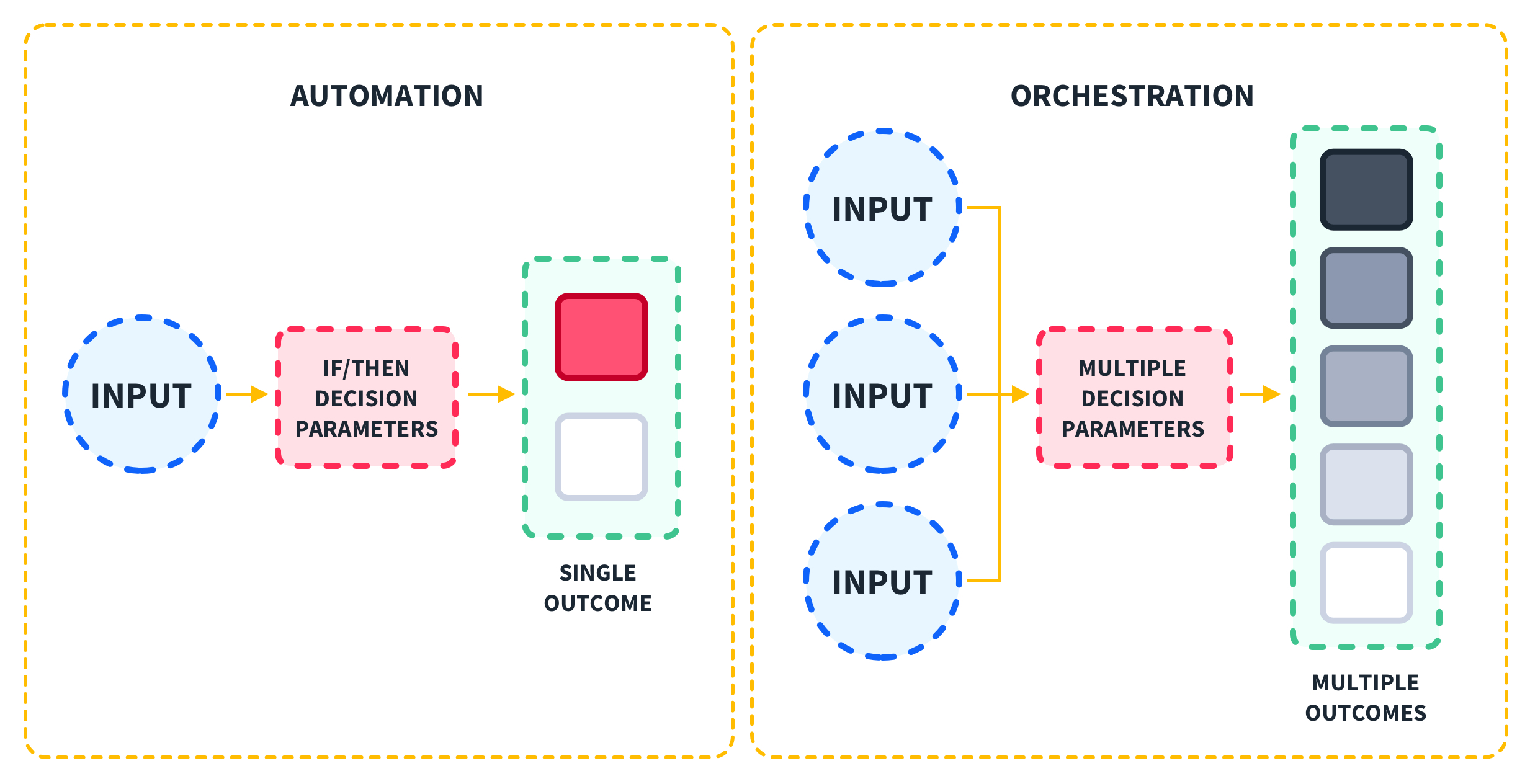Understanding Automation Vs Orchestration in IaC

Quick Definition: Infrastructure as code (IaC) is a method of managing and provisioning infrastructure through code, which enables version control, faster and safer deployments, and up-to-date documentation.
Many IT professionals consider Infrastructure as Code (IaC) a game changer. Once you delve into IaC, it’s easy to see why. IaC has revolutionized how we interact with hardware, providing scalability, automation, and ease of maintenance all in one package.
In short, Infrastructure as Code is a method of managing and provisioning infrastructure through code, which enables version control, faster and safer deployments, and up-to-date documentation.
While that is a high-level definition, IaC can be divided into two concepts: orchestration and automation. In this article, we’ll discuss the difference between the two and explore how to integrate each into your ecosystem.
Image Source: Altexsoft
How Does Automation Work in IaC?
When talking about IaC, automation is generally what comes to mind first. IaC was created to efficiently contend with the ever-growing hardware ecosystem associated with complex IT environments. IaC automation refers to provisioning virtual machines, physical servers, routers, firewalls, and more using code. This is done using a scripting language like YAML that is interpreted by an IaC interface (such as Ansible), making the requested changes.
IaC automation allows for the consistent and repeatable creation of the desired environment every time the code is run. It is also useful when hardware needs to be scaled up or down quickly and efficiently.
Benefits of Automation in Infrastructure Management
There are several benefits associated with automation infrastructure management, including:
Speed and Efficiency
Automating infrastructure deployment allows teams to quickly and consistently create and update infrastructure, reducing the time and effort required to manage complex environments.
Reliability and Consistency
By using code to define infrastructure, teams can ensure the same configuration is applied every time the code is executed, reducing the risk of configuration drift and ensuring consistent performance.
Scalability
Automated infrastructure provisioning makes it easy to scale infrastructure up or down as needed, allowing organizations to respond to changes in demand quickly.
Version Control
Since infrastructure is defined in code, it can be managed using version control systems. These systems make it easy to track changes and roll back to previous configurations if necessary.
Implementation of Automation in IaC
Now that we’ve discussed automation's pros and cons let’s walk through some practical implementations. It has never been a better time to leverage IaC since there are many different options, ranging from cloud-specific to on-premise solutions.
Ansible
Ansible is an open-source automation tool that can be used for configuration management and infrastructure provisioning. It uses a simple YAML-based syntax and supports various modules for interacting with cloud platforms and other services.
Chef
Chef is a configuration management and infrastructure automation tool that uses a domain-specific language (DSL) called "recipes" to define infrastructure configurations. The DSL is almost always written in Ruby. Also, it supports both declarative and procedural styles.
Puppet
Puppet is another configuration management and infrastructure automation tool that uses a declarative language to define the desired state of infrastructure resources. It supports multiple platforms, including cloud providers.
Infrastructure Provisioning Tool
Along with IaC scripting tools, infrastructure provisioning tools can be used in the cloud. Let’s walk through a couple of those.
Terraform
Terraform is a popular IaC tool developed by HashiCorp that uses declarative language and supports multiple cloud providers. It allows you to define infrastructure resources using code and then apply them to create, update, or destroy them accordingly.
AWS Cloud Formation
AWS CloudFormation is an IaC service that Amazon Web Services (AWS) provides. It lets you model and provision AWS resources using JSON or YAML format templates.
Azure Resource Manager (ARM)
ARM Templates are used to deploy and manage resources on Microsoft Azure. They allow you to define the infrastructure for Azure services in a declarative JSON format.
How Does Orchestration Work in IaC?
Orchestration in IaC is similar to automation but with a different objective. Orchestration refers to the desired state of the hardware ecosystem at large. Consider this: Let’s say you're running a web application that's rapidly gaining popularity.
Initially, you start with a single server to host your application. However, as more users join, that server starts struggling to handle the increased load. You decide to scale up by adding more servers to distribute the load.
Now, you face a new challenge: managing these servers efficiently. You must ensure your application runs smoothly across all servers, handle failures gracefully, and scale resources up or down based on demand. This is when IaC orchestration comes into play.
With that in mind, let’s discuss some of today's most popular orchestration tools.
Kubernetes
Developed by Google, Kubernetes has become the de facto standard for container orchestration. It provides extensive features for automating containerized applications' deployment, scaling, and management. Kubernetes has a large and active community and extensive documentation. It is supported by major cloud providers, making it popular for organizations of all sizes.
Docker Swarm
Docker Swarm is Docker's native orchestration tool, designed to manage clusters of Docker hosts and deploy containerized applications. It's simpler to set up and use than Kubernetes, making it a good choice for smaller teams or organizations already heavily invested in Docker. Bear in mind that Docker Swarm may lack some of Kubernetes' advanced features and scalability.
Challenges and Considerations in Orchestration
While container orchestration will save your organization time in the long run, there are still plenty of challenges to consider when starting the process. Here is a list of situations to remember when developing or maintaining an orchestrated environment.
Security
Orchestration tools manage networking configurations to enable communication between services on different nodes while ensuring network security and isolation. A developer forgetting to configure a firewall or other sensitive hardware could lead to a security breach.
Health Monitoring and Self-Healing
Orchestration platforms must monitor the health of application components and infrastructure resources and take measures to detect and mitigate failures or performance degradation. For example, if a cluster of pods is running out of RAM, there must be an alert. This typically involves automatic restarts of failed containers, rescheduling of workloads to healthy nodes, or triggering alerts for manual intervention.
Learning Curve
It’s no secret that Kubernetes and Docker Swarm are complicated. Both require specialized skills and knowledge. Organizations must invest in training their teams or hiring skilled professionals to operate these platforms effectively. Additional overhead will be incurred in managing the infrastructure, maintaining high availability, and ensuring compliance with best practices and security standards.
How Do You Integrate Automation and Orchestration in IaC?
Automation and orchestration in IaC go hand-in-hand. Orchestration can be thought of as the directing of several IaC automation scripts. There are several examples of this. Let’s look at how organizations use these real-world concepts to accomplish a task.
Continuous Integration in a CI/CD Pipeline
Orchestration plays a critical role in a DevOps pipeline. Orchestration software is used to build, test, and package software applications. Bamboo, Jenkins, and AWS CodePipeLine are the most common software for this. Specific scripts are written to ensure all applications are deployed uniformly and consistently.
Multi-Cloud Management
Orchestration is essential for managing workloads and resources across multiple cloud environments, such as Azure, Google Cloud, or hybrid cloud deployments. Orchestration tools like Kubernetes, HashiCorp Terraform, or cloud-native management platforms provide abstraction layers and APIs that enable the management and orchestration of resources across different cloud providers. These tools allow organizations to seamlessly deploy, scale, and manage applications across diverse cloud environments.
Infrastructure and Auto-Healing
Orchestration ensures infrastructure scalability and reliability by automating scaling and self-healing. Tools like Kubernetes and AWS Auto Scaling adjust resource levels dynamically based on workload demand while monitoring and triggering automated recovery actions for infrastructure failures. These mechanisms enhance distributed systems' availability, fault tolerance, and operational resilience.
Final Thoughts
Infrastructure as Code (IaC) has emerged as a game-changer in modern IT, offering scalability, automation, and ease of maintenance. By breaking it down into two main concepts—orchestration and automation—IaC empowers organizations to manage and provision infrastructure through code. This enables fast deployments and up-to-date documentation.
Remember that automation streamlines infrastructure management tasks while orchestration coordinates the overall environment, ensuring reliability, scalability, and seamless integration across different tools and platforms.
As organizations navigate the complexities of orchestrating their IT environments, they must address security, health monitoring, and the learning curve associated with orchestration tools like Kubernetes and Docker Swarm.
Finally, integrating automation and orchestration allows organizations to unlock the full potential of IaC. These potentials include Continuous Integration/Continuous Deployment pipelines, multi-cloud management, and infrastructure scaling and auto-healing.
Want to learn more about becoming a Network Engineer? Check out our Network+ online training.
delivered to your inbox.
By submitting this form you agree to receive marketing emails from CBT Nuggets and that you have read, understood and are able to consent to our privacy policy.

